A David & Co Limited: An Organisational Behaviour Analysis Report
VerifiedAdded on 2020/12/09
|15
|4899
|390
Report
AI Summary
This report provides an analysis of organisational behaviour within A David & Co Limited, a food and beverage company. It explores key concepts including organisational culture (power, role, task, and person cultures), power dynamics (coercive, reward, and referent power), and organisational politics. The report delves into content and process theories of motivation, such as Maslow's hierarchy of needs, Vroom's expectancy theory, and motivational techniques like positive work environments and incentives. It also examines different types of teams, effective team characteristics, and the Tuckman and Jensen's model of team development. The report concludes by discussing the benefits of teamwork and the path-goal theory, along with its potential barriers. Overall, the report provides a comprehensive overview of organisational behaviour principles applied to the context of A David & Co Limited.
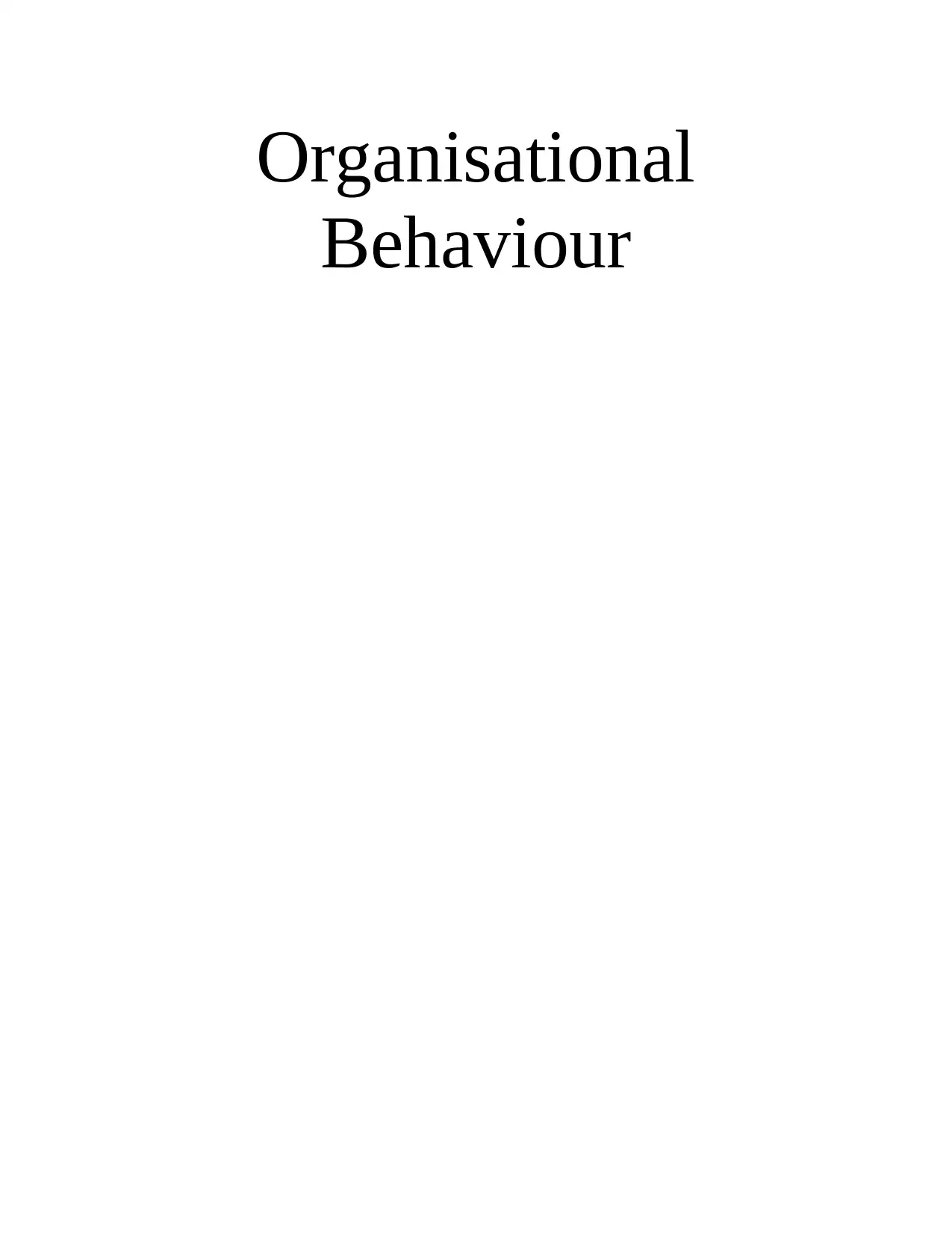
Organisational
Behaviour
Behaviour
Paraphrase This Document
Need a fresh take? Get an instant paraphrase of this document with our AI Paraphraser

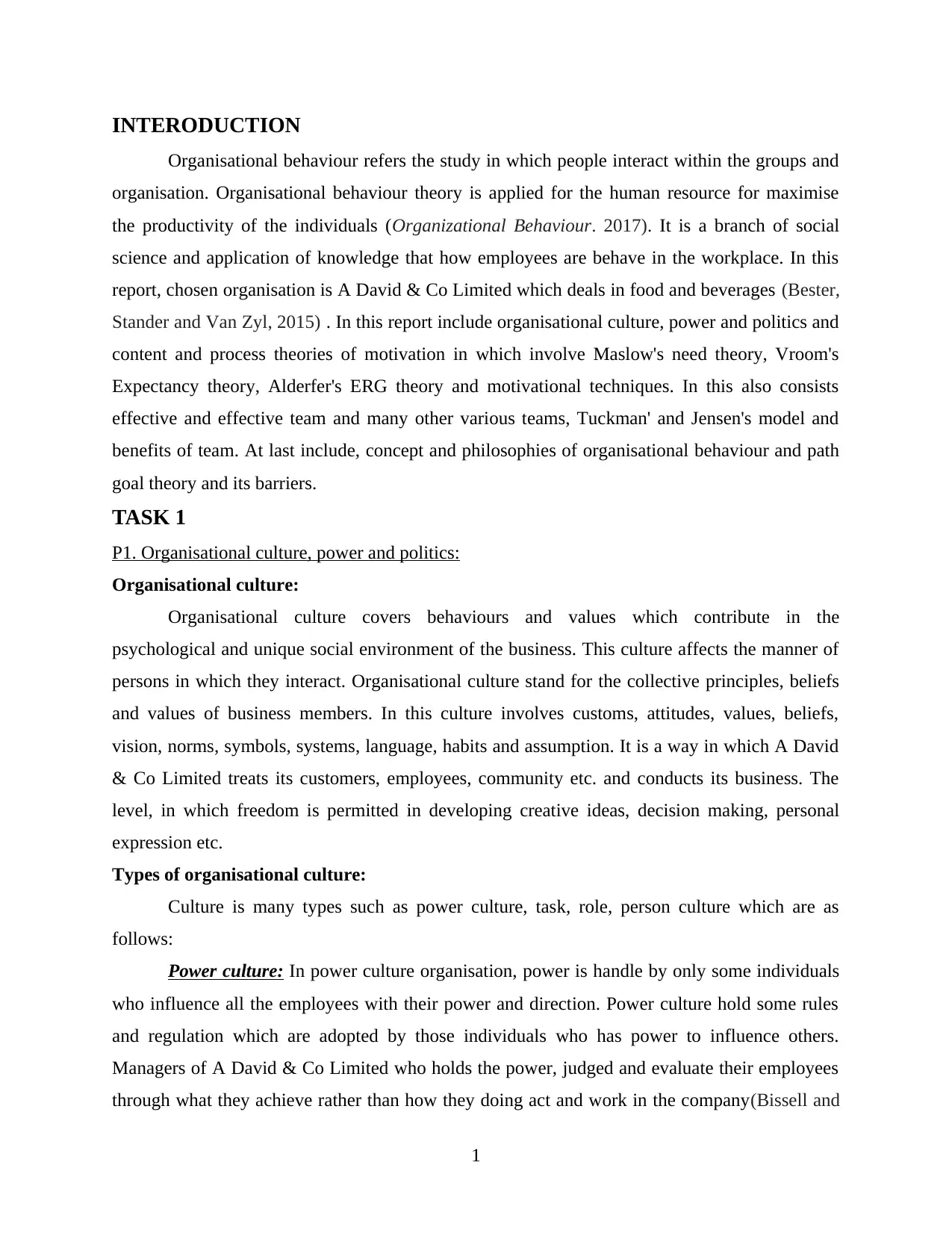
INTERODUCTION
Organisational behaviour refers the study in which people interact within the groups and
organisation. Organisational behaviour theory is applied for the human resource for maximise
the productivity of the individuals (Organizational Behaviour. 2017). It is a branch of social
science and application of knowledge that how employees are behave in the workplace. In this
report, chosen organisation is A David & Co Limited which deals in food and beverages (Bester,
Stander and Van Zyl, 2015) . In this report include organisational culture, power and politics and
content and process theories of motivation in which involve Maslow's need theory, Vroom's
Expectancy theory, Alderfer's ERG theory and motivational techniques. In this also consists
effective and effective team and many other various teams, Tuckman' and Jensen's model and
benefits of team. At last include, concept and philosophies of organisational behaviour and path
goal theory and its barriers.
TASK 1
P1. Organisational culture, power and politics:
Organisational culture:
Organisational culture covers behaviours and values which contribute in the
psychological and unique social environment of the business. This culture affects the manner of
persons in which they interact. Organisational culture stand for the collective principles, beliefs
and values of business members. In this culture involves customs, attitudes, values, beliefs,
vision, norms, symbols, systems, language, habits and assumption. It is a way in which A David
& Co Limited treats its customers, employees, community etc. and conducts its business. The
level, in which freedom is permitted in developing creative ideas, decision making, personal
expression etc.
Types of organisational culture:
Culture is many types such as power culture, task, role, person culture which are as
follows:
Power culture: In power culture organisation, power is handle by only some individuals
who influence all the employees with their power and direction. Power culture hold some rules
and regulation which are adopted by those individuals who has power to influence others.
Managers of A David & Co Limited who holds the power, judged and evaluate their employees
through what they achieve rather than how they doing act and work in the company(Bissell and
1
Organisational behaviour refers the study in which people interact within the groups and
organisation. Organisational behaviour theory is applied for the human resource for maximise
the productivity of the individuals (Organizational Behaviour. 2017). It is a branch of social
science and application of knowledge that how employees are behave in the workplace. In this
report, chosen organisation is A David & Co Limited which deals in food and beverages (Bester,
Stander and Van Zyl, 2015) . In this report include organisational culture, power and politics and
content and process theories of motivation in which involve Maslow's need theory, Vroom's
Expectancy theory, Alderfer's ERG theory and motivational techniques. In this also consists
effective and effective team and many other various teams, Tuckman' and Jensen's model and
benefits of team. At last include, concept and philosophies of organisational behaviour and path
goal theory and its barriers.
TASK 1
P1. Organisational culture, power and politics:
Organisational culture:
Organisational culture covers behaviours and values which contribute in the
psychological and unique social environment of the business. This culture affects the manner of
persons in which they interact. Organisational culture stand for the collective principles, beliefs
and values of business members. In this culture involves customs, attitudes, values, beliefs,
vision, norms, symbols, systems, language, habits and assumption. It is a way in which A David
& Co Limited treats its customers, employees, community etc. and conducts its business. The
level, in which freedom is permitted in developing creative ideas, decision making, personal
expression etc.
Types of organisational culture:
Culture is many types such as power culture, task, role, person culture which are as
follows:
Power culture: In power culture organisation, power is handle by only some individuals
who influence all the employees with their power and direction. Power culture hold some rules
and regulation which are adopted by those individuals who has power to influence others.
Managers of A David & Co Limited who holds the power, judged and evaluate their employees
through what they achieve rather than how they doing act and work in the company(Bissell and
1
⊘ This is a preview!⊘
Do you want full access?
Subscribe today to unlock all pages.

Trusted by 1+ million students worldwide
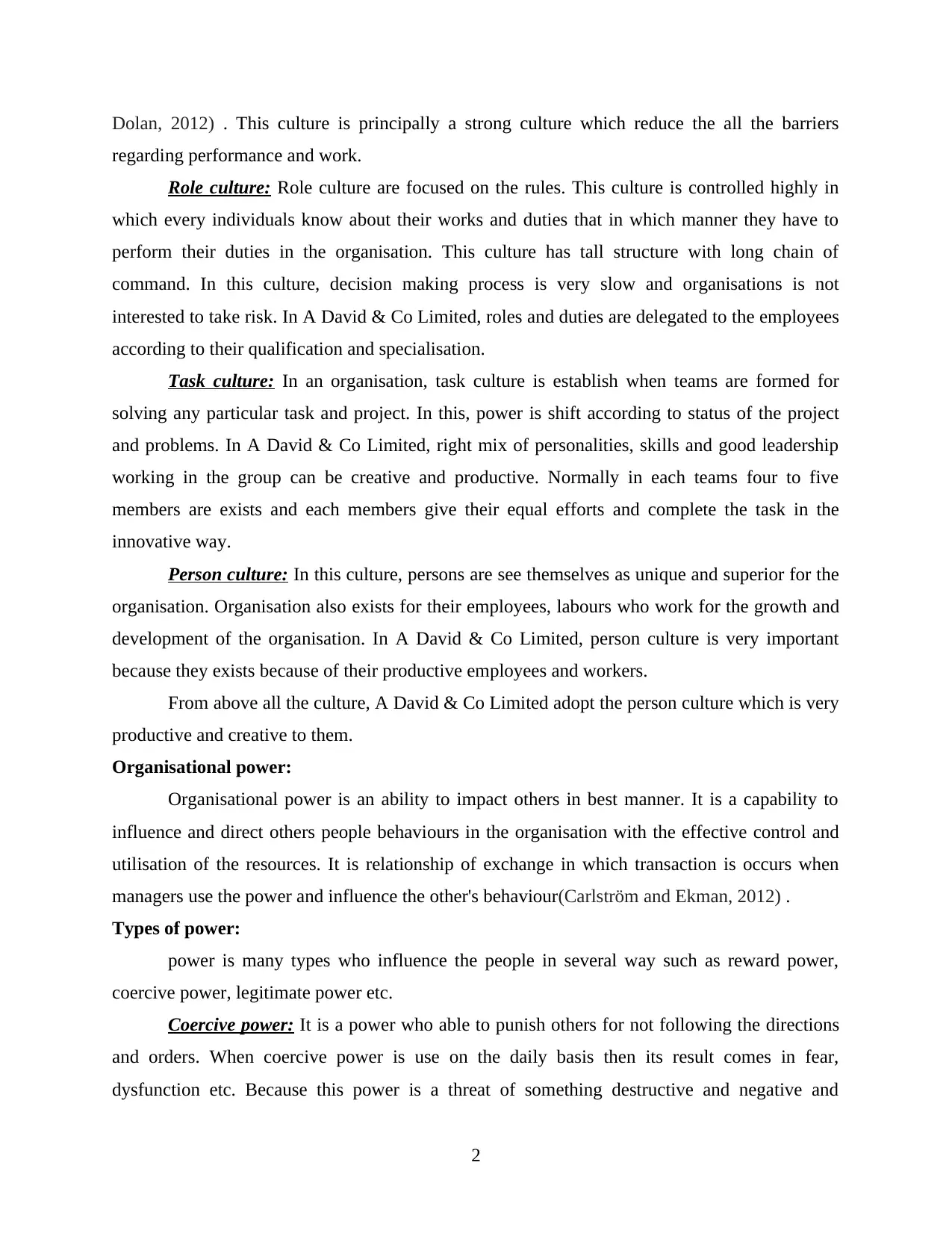
Dolan, 2012) . This culture is principally a strong culture which reduce the all the barriers
regarding performance and work.
Role culture: Role culture are focused on the rules. This culture is controlled highly in
which every individuals know about their works and duties that in which manner they have to
perform their duties in the organisation. This culture has tall structure with long chain of
command. In this culture, decision making process is very slow and organisations is not
interested to take risk. In A David & Co Limited, roles and duties are delegated to the employees
according to their qualification and specialisation.
Task culture: In an organisation, task culture is establish when teams are formed for
solving any particular task and project. In this, power is shift according to status of the project
and problems. In A David & Co Limited, right mix of personalities, skills and good leadership
working in the group can be creative and productive. Normally in each teams four to five
members are exists and each members give their equal efforts and complete the task in the
innovative way.
Person culture: In this culture, persons are see themselves as unique and superior for the
organisation. Organisation also exists for their employees, labours who work for the growth and
development of the organisation. In A David & Co Limited, person culture is very important
because they exists because of their productive employees and workers.
From above all the culture, A David & Co Limited adopt the person culture which is very
productive and creative to them.
Organisational power:
Organisational power is an ability to impact others in best manner. It is a capability to
influence and direct others people behaviours in the organisation with the effective control and
utilisation of the resources. It is relationship of exchange in which transaction is occurs when
managers use the power and influence the other's behaviour(Carlström and Ekman, 2012) .
Types of power:
power is many types who influence the people in several way such as reward power,
coercive power, legitimate power etc.
Coercive power: It is a power who able to punish others for not following the directions
and orders. When coercive power is use on the daily basis then its result comes in fear,
dysfunction etc. Because this power is a threat of something destructive and negative and
2
regarding performance and work.
Role culture: Role culture are focused on the rules. This culture is controlled highly in
which every individuals know about their works and duties that in which manner they have to
perform their duties in the organisation. This culture has tall structure with long chain of
command. In this culture, decision making process is very slow and organisations is not
interested to take risk. In A David & Co Limited, roles and duties are delegated to the employees
according to their qualification and specialisation.
Task culture: In an organisation, task culture is establish when teams are formed for
solving any particular task and project. In this, power is shift according to status of the project
and problems. In A David & Co Limited, right mix of personalities, skills and good leadership
working in the group can be creative and productive. Normally in each teams four to five
members are exists and each members give their equal efforts and complete the task in the
innovative way.
Person culture: In this culture, persons are see themselves as unique and superior for the
organisation. Organisation also exists for their employees, labours who work for the growth and
development of the organisation. In A David & Co Limited, person culture is very important
because they exists because of their productive employees and workers.
From above all the culture, A David & Co Limited adopt the person culture which is very
productive and creative to them.
Organisational power:
Organisational power is an ability to impact others in best manner. It is a capability to
influence and direct others people behaviours in the organisation with the effective control and
utilisation of the resources. It is relationship of exchange in which transaction is occurs when
managers use the power and influence the other's behaviour(Carlström and Ekman, 2012) .
Types of power:
power is many types who influence the people in several way such as reward power,
coercive power, legitimate power etc.
Coercive power: It is a power who able to punish others for not following the directions
and orders. When coercive power is use on the daily basis then its result comes in fear,
dysfunction etc. Because this power is a threat of something destructive and negative and
2
Paraphrase This Document
Need a fresh take? Get an instant paraphrase of this document with our AI Paraphraser
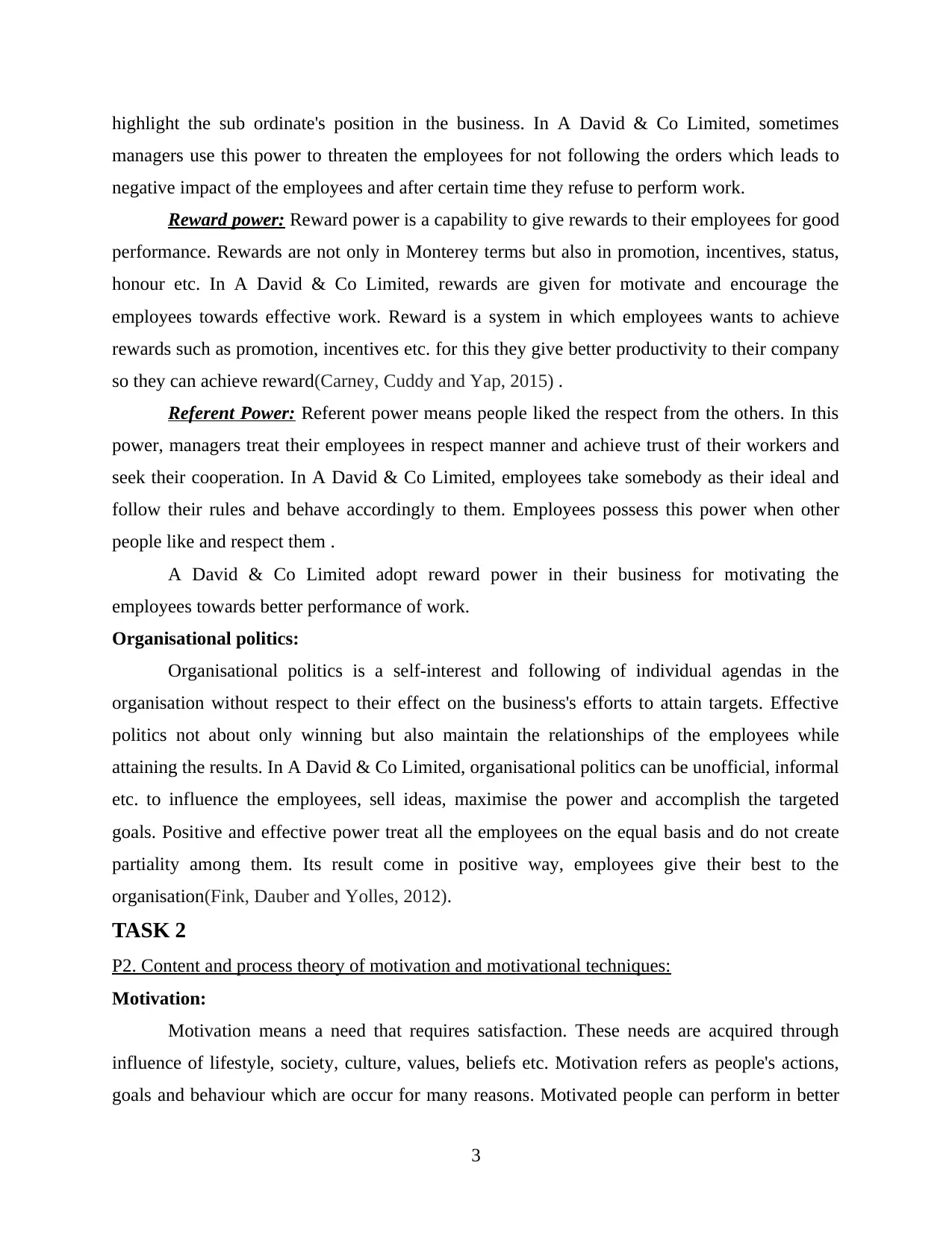
highlight the sub ordinate's position in the business. In A David & Co Limited, sometimes
managers use this power to threaten the employees for not following the orders which leads to
negative impact of the employees and after certain time they refuse to perform work.
Reward power: Reward power is a capability to give rewards to their employees for good
performance. Rewards are not only in Monterey terms but also in promotion, incentives, status,
honour etc. In A David & Co Limited, rewards are given for motivate and encourage the
employees towards effective work. Reward is a system in which employees wants to achieve
rewards such as promotion, incentives etc. for this they give better productivity to their company
so they can achieve reward(Carney, Cuddy and Yap, 2015) .
Referent Power: Referent power means people liked the respect from the others. In this
power, managers treat their employees in respect manner and achieve trust of their workers and
seek their cooperation. In A David & Co Limited, employees take somebody as their ideal and
follow their rules and behave accordingly to them. Employees possess this power when other
people like and respect them .
A David & Co Limited adopt reward power in their business for motivating the
employees towards better performance of work.
Organisational politics:
Organisational politics is a self-interest and following of individual agendas in the
organisation without respect to their effect on the business's efforts to attain targets. Effective
politics not about only winning but also maintain the relationships of the employees while
attaining the results. In A David & Co Limited, organisational politics can be unofficial, informal
etc. to influence the employees, sell ideas, maximise the power and accomplish the targeted
goals. Positive and effective power treat all the employees on the equal basis and do not create
partiality among them. Its result come in positive way, employees give their best to the
organisation(Fink, Dauber and Yolles, 2012).
TASK 2
P2. Content and process theory of motivation and motivational techniques:
Motivation:
Motivation means a need that requires satisfaction. These needs are acquired through
influence of lifestyle, society, culture, values, beliefs etc. Motivation refers as people's actions,
goals and behaviour which are occur for many reasons. Motivated people can perform in better
3
managers use this power to threaten the employees for not following the orders which leads to
negative impact of the employees and after certain time they refuse to perform work.
Reward power: Reward power is a capability to give rewards to their employees for good
performance. Rewards are not only in Monterey terms but also in promotion, incentives, status,
honour etc. In A David & Co Limited, rewards are given for motivate and encourage the
employees towards effective work. Reward is a system in which employees wants to achieve
rewards such as promotion, incentives etc. for this they give better productivity to their company
so they can achieve reward(Carney, Cuddy and Yap, 2015) .
Referent Power: Referent power means people liked the respect from the others. In this
power, managers treat their employees in respect manner and achieve trust of their workers and
seek their cooperation. In A David & Co Limited, employees take somebody as their ideal and
follow their rules and behave accordingly to them. Employees possess this power when other
people like and respect them .
A David & Co Limited adopt reward power in their business for motivating the
employees towards better performance of work.
Organisational politics:
Organisational politics is a self-interest and following of individual agendas in the
organisation without respect to their effect on the business's efforts to attain targets. Effective
politics not about only winning but also maintain the relationships of the employees while
attaining the results. In A David & Co Limited, organisational politics can be unofficial, informal
etc. to influence the employees, sell ideas, maximise the power and accomplish the targeted
goals. Positive and effective power treat all the employees on the equal basis and do not create
partiality among them. Its result come in positive way, employees give their best to the
organisation(Fink, Dauber and Yolles, 2012).
TASK 2
P2. Content and process theory of motivation and motivational techniques:
Motivation:
Motivation means a need that requires satisfaction. These needs are acquired through
influence of lifestyle, society, culture, values, beliefs etc. Motivation refers as people's actions,
goals and behaviour which are occur for many reasons. Motivated people can perform in better
3
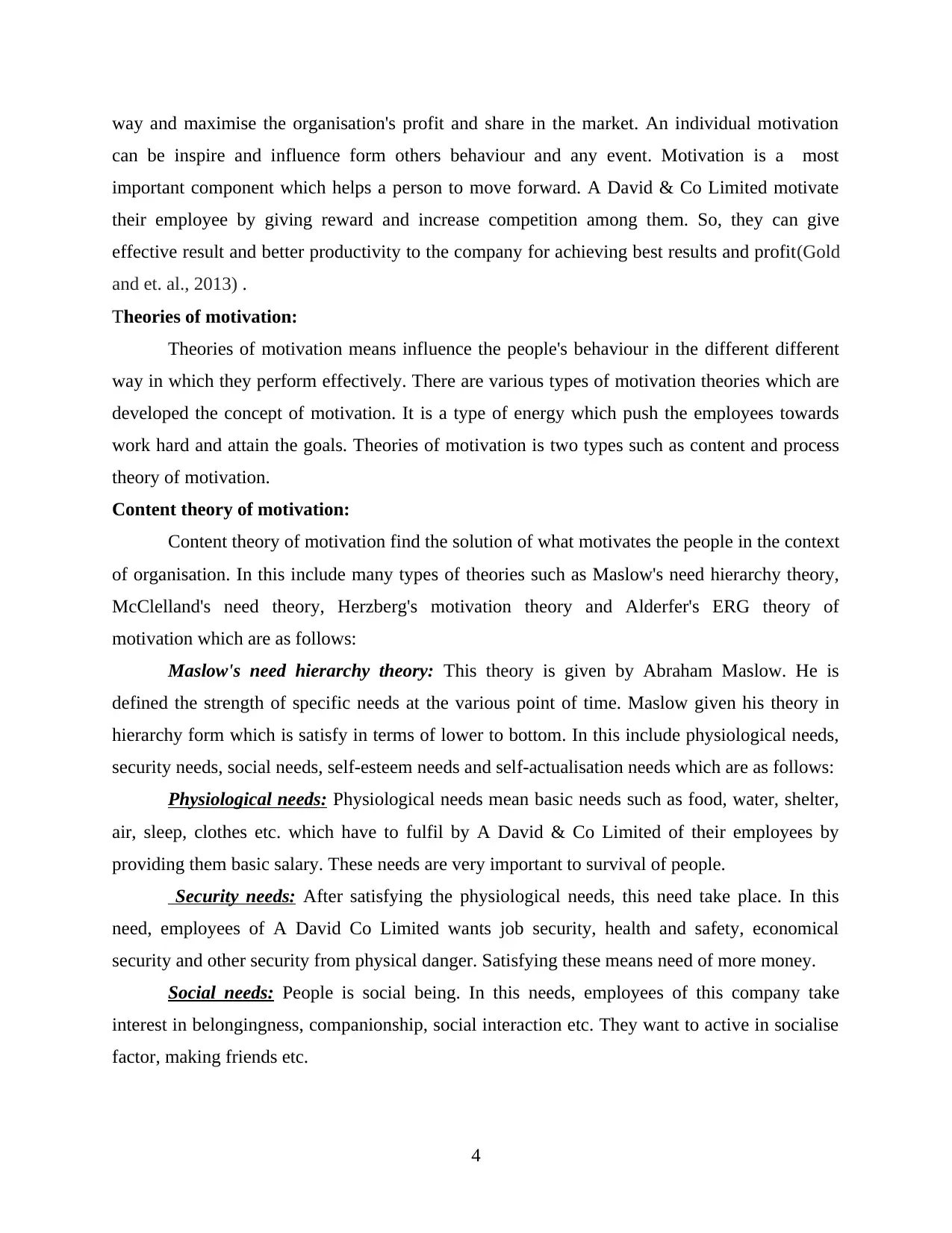
way and maximise the organisation's profit and share in the market. An individual motivation
can be inspire and influence form others behaviour and any event. Motivation is a most
important component which helps a person to move forward. A David & Co Limited motivate
their employee by giving reward and increase competition among them. So, they can give
effective result and better productivity to the company for achieving best results and profit(Gold
and et. al., 2013) .
Theories of motivation:
Theories of motivation means influence the people's behaviour in the different different
way in which they perform effectively. There are various types of motivation theories which are
developed the concept of motivation. It is a type of energy which push the employees towards
work hard and attain the goals. Theories of motivation is two types such as content and process
theory of motivation.
Content theory of motivation:
Content theory of motivation find the solution of what motivates the people in the context
of organisation. In this include many types of theories such as Maslow's need hierarchy theory,
McClelland's need theory, Herzberg's motivation theory and Alderfer's ERG theory of
motivation which are as follows:
Maslow's need hierarchy theory: This theory is given by Abraham Maslow. He is
defined the strength of specific needs at the various point of time. Maslow given his theory in
hierarchy form which is satisfy in terms of lower to bottom. In this include physiological needs,
security needs, social needs, self-esteem needs and self-actualisation needs which are as follows:
Physiological needs: Physiological needs mean basic needs such as food, water, shelter,
air, sleep, clothes etc. which have to fulfil by A David & Co Limited of their employees by
providing them basic salary. These needs are very important to survival of people.
Security needs: After satisfying the physiological needs, this need take place. In this
need, employees of A David Co Limited wants job security, health and safety, economical
security and other security from physical danger. Satisfying these means need of more money.
Social needs: People is social being. In this needs, employees of this company take
interest in belongingness, companionship, social interaction etc. They want to active in socialise
factor, making friends etc.
4
can be inspire and influence form others behaviour and any event. Motivation is a most
important component which helps a person to move forward. A David & Co Limited motivate
their employee by giving reward and increase competition among them. So, they can give
effective result and better productivity to the company for achieving best results and profit(Gold
and et. al., 2013) .
Theories of motivation:
Theories of motivation means influence the people's behaviour in the different different
way in which they perform effectively. There are various types of motivation theories which are
developed the concept of motivation. It is a type of energy which push the employees towards
work hard and attain the goals. Theories of motivation is two types such as content and process
theory of motivation.
Content theory of motivation:
Content theory of motivation find the solution of what motivates the people in the context
of organisation. In this include many types of theories such as Maslow's need hierarchy theory,
McClelland's need theory, Herzberg's motivation theory and Alderfer's ERG theory of
motivation which are as follows:
Maslow's need hierarchy theory: This theory is given by Abraham Maslow. He is
defined the strength of specific needs at the various point of time. Maslow given his theory in
hierarchy form which is satisfy in terms of lower to bottom. In this include physiological needs,
security needs, social needs, self-esteem needs and self-actualisation needs which are as follows:
Physiological needs: Physiological needs mean basic needs such as food, water, shelter,
air, sleep, clothes etc. which have to fulfil by A David & Co Limited of their employees by
providing them basic salary. These needs are very important to survival of people.
Security needs: After satisfying the physiological needs, this need take place. In this
need, employees of A David Co Limited wants job security, health and safety, economical
security and other security from physical danger. Satisfying these means need of more money.
Social needs: People is social being. In this needs, employees of this company take
interest in belongingness, companionship, social interaction etc. They want to active in socialise
factor, making friends etc.
4
⊘ This is a preview!⊘
Do you want full access?
Subscribe today to unlock all pages.

Trusted by 1+ million students worldwide
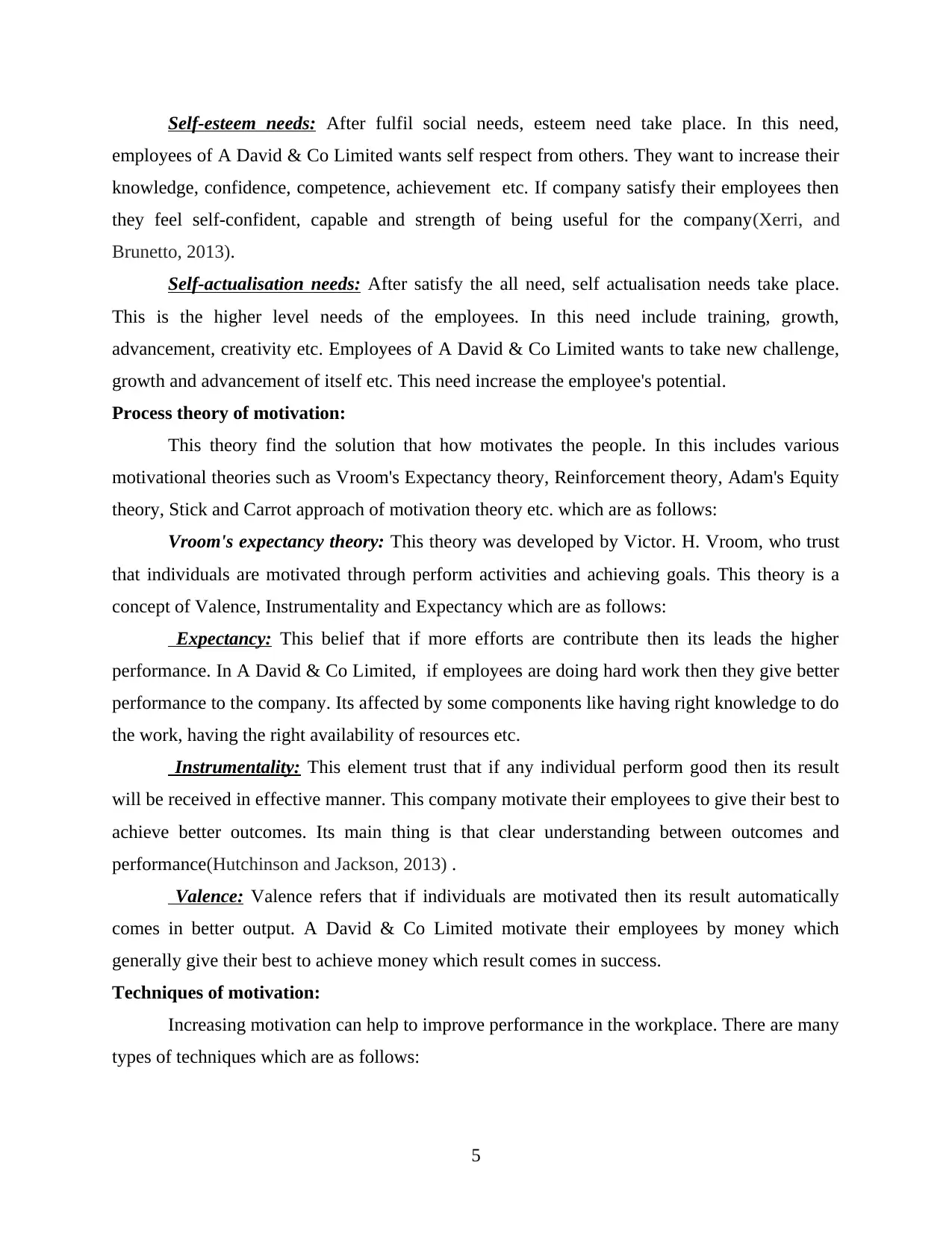
Self-esteem needs: After fulfil social needs, esteem need take place. In this need,
employees of A David & Co Limited wants self respect from others. They want to increase their
knowledge, confidence, competence, achievement etc. If company satisfy their employees then
they feel self-confident, capable and strength of being useful for the company(Xerri, and
Brunetto, 2013).
Self-actualisation needs: After satisfy the all need, self actualisation needs take place.
This is the higher level needs of the employees. In this need include training, growth,
advancement, creativity etc. Employees of A David & Co Limited wants to take new challenge,
growth and advancement of itself etc. This need increase the employee's potential.
Process theory of motivation:
This theory find the solution that how motivates the people. In this includes various
motivational theories such as Vroom's Expectancy theory, Reinforcement theory, Adam's Equity
theory, Stick and Carrot approach of motivation theory etc. which are as follows:
Vroom's expectancy theory: This theory was developed by Victor. H. Vroom, who trust
that individuals are motivated through perform activities and achieving goals. This theory is a
concept of Valence, Instrumentality and Expectancy which are as follows:
Expectancy: This belief that if more efforts are contribute then its leads the higher
performance. In A David & Co Limited, if employees are doing hard work then they give better
performance to the company. Its affected by some components like having right knowledge to do
the work, having the right availability of resources etc.
Instrumentality: This element trust that if any individual perform good then its result
will be received in effective manner. This company motivate their employees to give their best to
achieve better outcomes. Its main thing is that clear understanding between outcomes and
performance(Hutchinson and Jackson, 2013) .
Valence: Valence refers that if individuals are motivated then its result automatically
comes in better output. A David & Co Limited motivate their employees by money which
generally give their best to achieve money which result comes in success.
Techniques of motivation:
Increasing motivation can help to improve performance in the workplace. There are many
types of techniques which are as follows:
5
employees of A David & Co Limited wants self respect from others. They want to increase their
knowledge, confidence, competence, achievement etc. If company satisfy their employees then
they feel self-confident, capable and strength of being useful for the company(Xerri, and
Brunetto, 2013).
Self-actualisation needs: After satisfy the all need, self actualisation needs take place.
This is the higher level needs of the employees. In this need include training, growth,
advancement, creativity etc. Employees of A David & Co Limited wants to take new challenge,
growth and advancement of itself etc. This need increase the employee's potential.
Process theory of motivation:
This theory find the solution that how motivates the people. In this includes various
motivational theories such as Vroom's Expectancy theory, Reinforcement theory, Adam's Equity
theory, Stick and Carrot approach of motivation theory etc. which are as follows:
Vroom's expectancy theory: This theory was developed by Victor. H. Vroom, who trust
that individuals are motivated through perform activities and achieving goals. This theory is a
concept of Valence, Instrumentality and Expectancy which are as follows:
Expectancy: This belief that if more efforts are contribute then its leads the higher
performance. In A David & Co Limited, if employees are doing hard work then they give better
performance to the company. Its affected by some components like having right knowledge to do
the work, having the right availability of resources etc.
Instrumentality: This element trust that if any individual perform good then its result
will be received in effective manner. This company motivate their employees to give their best to
achieve better outcomes. Its main thing is that clear understanding between outcomes and
performance(Hutchinson and Jackson, 2013) .
Valence: Valence refers that if individuals are motivated then its result automatically
comes in better output. A David & Co Limited motivate their employees by money which
generally give their best to achieve money which result comes in success.
Techniques of motivation:
Increasing motivation can help to improve performance in the workplace. There are many
types of techniques which are as follows:
5
Paraphrase This Document
Need a fresh take? Get an instant paraphrase of this document with our AI Paraphraser
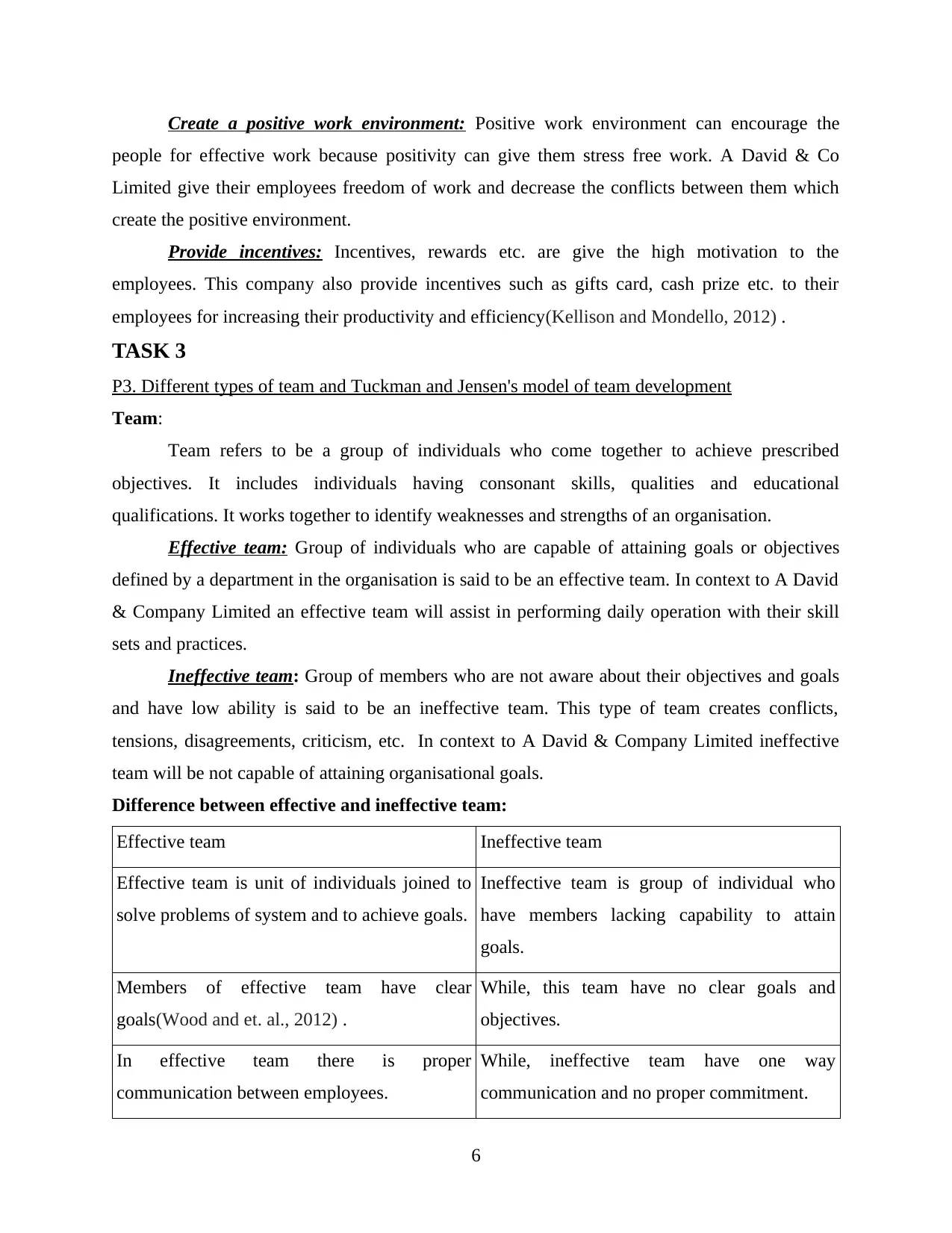
Create a positive work environment: Positive work environment can encourage the
people for effective work because positivity can give them stress free work. A David & Co
Limited give their employees freedom of work and decrease the conflicts between them which
create the positive environment.
Provide incentives: Incentives, rewards etc. are give the high motivation to the
employees. This company also provide incentives such as gifts card, cash prize etc. to their
employees for increasing their productivity and efficiency(Kellison and Mondello, 2012) .
TASK 3
P3. Different types of team and Tuckman and Jensen's model of team development
Team:
Team refers to be a group of individuals who come together to achieve prescribed
objectives. It includes individuals having consonant skills, qualities and educational
qualifications. It works together to identify weaknesses and strengths of an organisation.
Effective team: Group of individuals who are capable of attaining goals or objectives
defined by a department in the organisation is said to be an effective team. In context to A David
& Company Limited an effective team will assist in performing daily operation with their skill
sets and practices.
Ineffective team: Group of members who are not aware about their objectives and goals
and have low ability is said to be an ineffective team. This type of team creates conflicts,
tensions, disagreements, criticism, etc. In context to A David & Company Limited ineffective
team will be not capable of attaining organisational goals.
Difference between effective and ineffective team:
Effective team Ineffective team
Effective team is unit of individuals joined to
solve problems of system and to achieve goals.
Ineffective team is group of individual who
have members lacking capability to attain
goals.
Members of effective team have clear
goals(Wood and et. al., 2012) .
While, this team have no clear goals and
objectives.
In effective team there is proper
communication between employees.
While, ineffective team have one way
communication and no proper commitment.
6
people for effective work because positivity can give them stress free work. A David & Co
Limited give their employees freedom of work and decrease the conflicts between them which
create the positive environment.
Provide incentives: Incentives, rewards etc. are give the high motivation to the
employees. This company also provide incentives such as gifts card, cash prize etc. to their
employees for increasing their productivity and efficiency(Kellison and Mondello, 2012) .
TASK 3
P3. Different types of team and Tuckman and Jensen's model of team development
Team:
Team refers to be a group of individuals who come together to achieve prescribed
objectives. It includes individuals having consonant skills, qualities and educational
qualifications. It works together to identify weaknesses and strengths of an organisation.
Effective team: Group of individuals who are capable of attaining goals or objectives
defined by a department in the organisation is said to be an effective team. In context to A David
& Company Limited an effective team will assist in performing daily operation with their skill
sets and practices.
Ineffective team: Group of members who are not aware about their objectives and goals
and have low ability is said to be an ineffective team. This type of team creates conflicts,
tensions, disagreements, criticism, etc. In context to A David & Company Limited ineffective
team will be not capable of attaining organisational goals.
Difference between effective and ineffective team:
Effective team Ineffective team
Effective team is unit of individuals joined to
solve problems of system and to achieve goals.
Ineffective team is group of individual who
have members lacking capability to attain
goals.
Members of effective team have clear
goals(Wood and et. al., 2012) .
While, this team have no clear goals and
objectives.
In effective team there is proper
communication between employees.
While, ineffective team have one way
communication and no proper commitment.
6
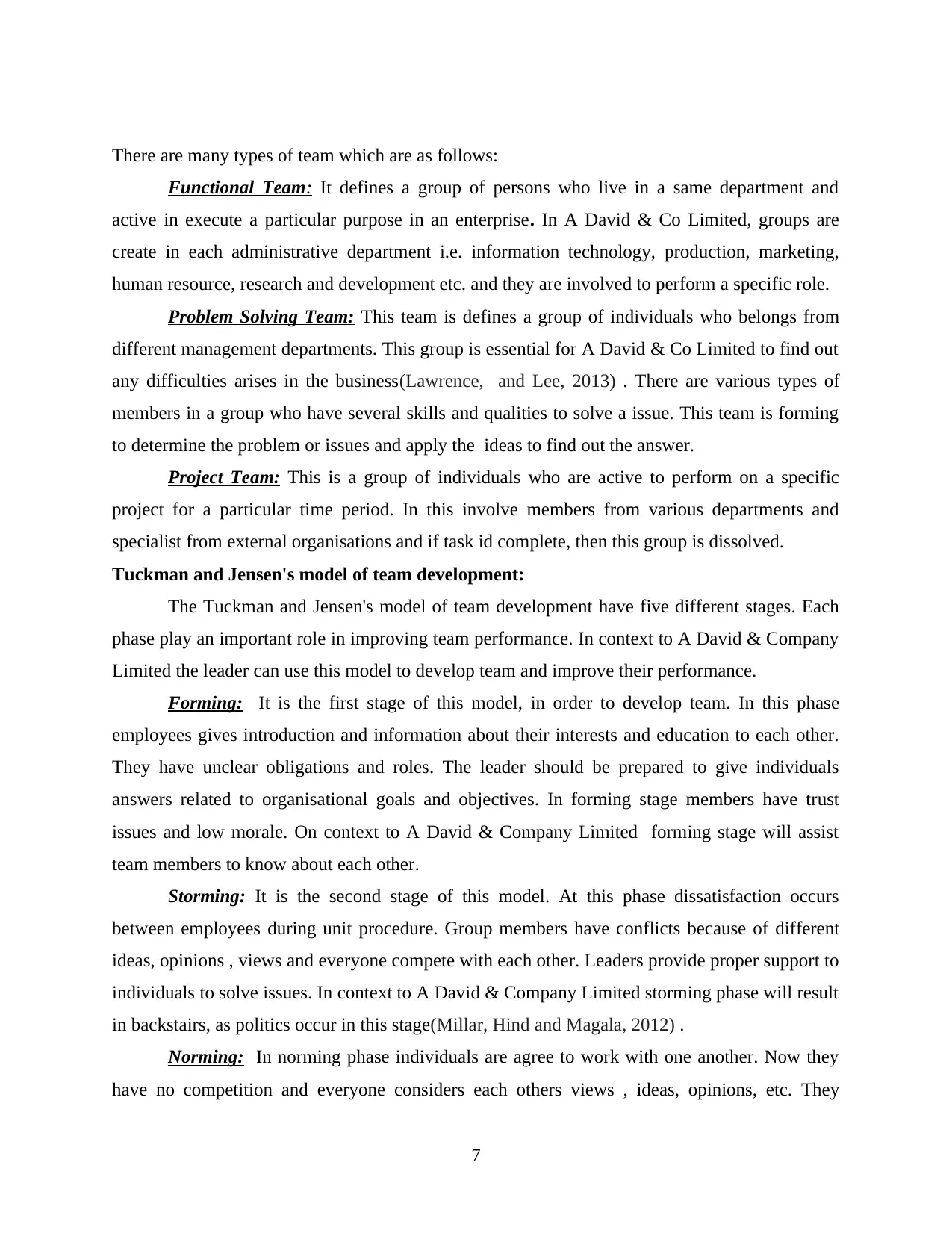
There are many types of team which are as follows:
Functional Team: It defines a group of persons who live in a same department and
active in execute a particular purpose in an enterprise. In A David & Co Limited, groups are
create in each administrative department i.e. information technology, production, marketing,
human resource, research and development etc. and they are involved to perform a specific role.
Problem Solving Team: This team is defines a group of individuals who belongs from
different management departments. This group is essential for A David & Co Limited to find out
any difficulties arises in the business(Lawrence, and Lee, 2013) . There are various types of
members in a group who have several skills and qualities to solve a issue. This team is forming
to determine the problem or issues and apply the ideas to find out the answer.
Project Team: This is a group of individuals who are active to perform on a specific
project for a particular time period. In this involve members from various departments and
specialist from external organisations and if task id complete, then this group is dissolved.
Tuckman and Jensen's model of team development:
The Tuckman and Jensen's model of team development have five different stages. Each
phase play an important role in improving team performance. In context to A David & Company
Limited the leader can use this model to develop team and improve their performance.
Forming: It is the first stage of this model, in order to develop team. In this phase
employees gives introduction and information about their interests and education to each other.
They have unclear obligations and roles. The leader should be prepared to give individuals
answers related to organisational goals and objectives. In forming stage members have trust
issues and low morale. On context to A David & Company Limited forming stage will assist
team members to know about each other.
Storming: It is the second stage of this model. At this phase dissatisfaction occurs
between employees during unit procedure. Group members have conflicts because of different
ideas, opinions , views and everyone compete with each other. Leaders provide proper support to
individuals to solve issues. In context to A David & Company Limited storming phase will result
in backstairs, as politics occur in this stage(Millar, Hind and Magala, 2012) .
Norming: In norming phase individuals are agree to work with one another. Now they
have no competition and everyone considers each others views , ideas, opinions, etc. They
7
Functional Team: It defines a group of persons who live in a same department and
active in execute a particular purpose in an enterprise. In A David & Co Limited, groups are
create in each administrative department i.e. information technology, production, marketing,
human resource, research and development etc. and they are involved to perform a specific role.
Problem Solving Team: This team is defines a group of individuals who belongs from
different management departments. This group is essential for A David & Co Limited to find out
any difficulties arises in the business(Lawrence, and Lee, 2013) . There are various types of
members in a group who have several skills and qualities to solve a issue. This team is forming
to determine the problem or issues and apply the ideas to find out the answer.
Project Team: This is a group of individuals who are active to perform on a specific
project for a particular time period. In this involve members from various departments and
specialist from external organisations and if task id complete, then this group is dissolved.
Tuckman and Jensen's model of team development:
The Tuckman and Jensen's model of team development have five different stages. Each
phase play an important role in improving team performance. In context to A David & Company
Limited the leader can use this model to develop team and improve their performance.
Forming: It is the first stage of this model, in order to develop team. In this phase
employees gives introduction and information about their interests and education to each other.
They have unclear obligations and roles. The leader should be prepared to give individuals
answers related to organisational goals and objectives. In forming stage members have trust
issues and low morale. On context to A David & Company Limited forming stage will assist
team members to know about each other.
Storming: It is the second stage of this model. At this phase dissatisfaction occurs
between employees during unit procedure. Group members have conflicts because of different
ideas, opinions , views and everyone compete with each other. Leaders provide proper support to
individuals to solve issues. In context to A David & Company Limited storming phase will result
in backstairs, as politics occur in this stage(Millar, Hind and Magala, 2012) .
Norming: In norming phase individuals are agree to work with one another. Now they
have no competition and everyone considers each others views , ideas, opinions, etc. They
7
⊘ This is a preview!⊘
Do you want full access?
Subscribe today to unlock all pages.

Trusted by 1+ million students worldwide
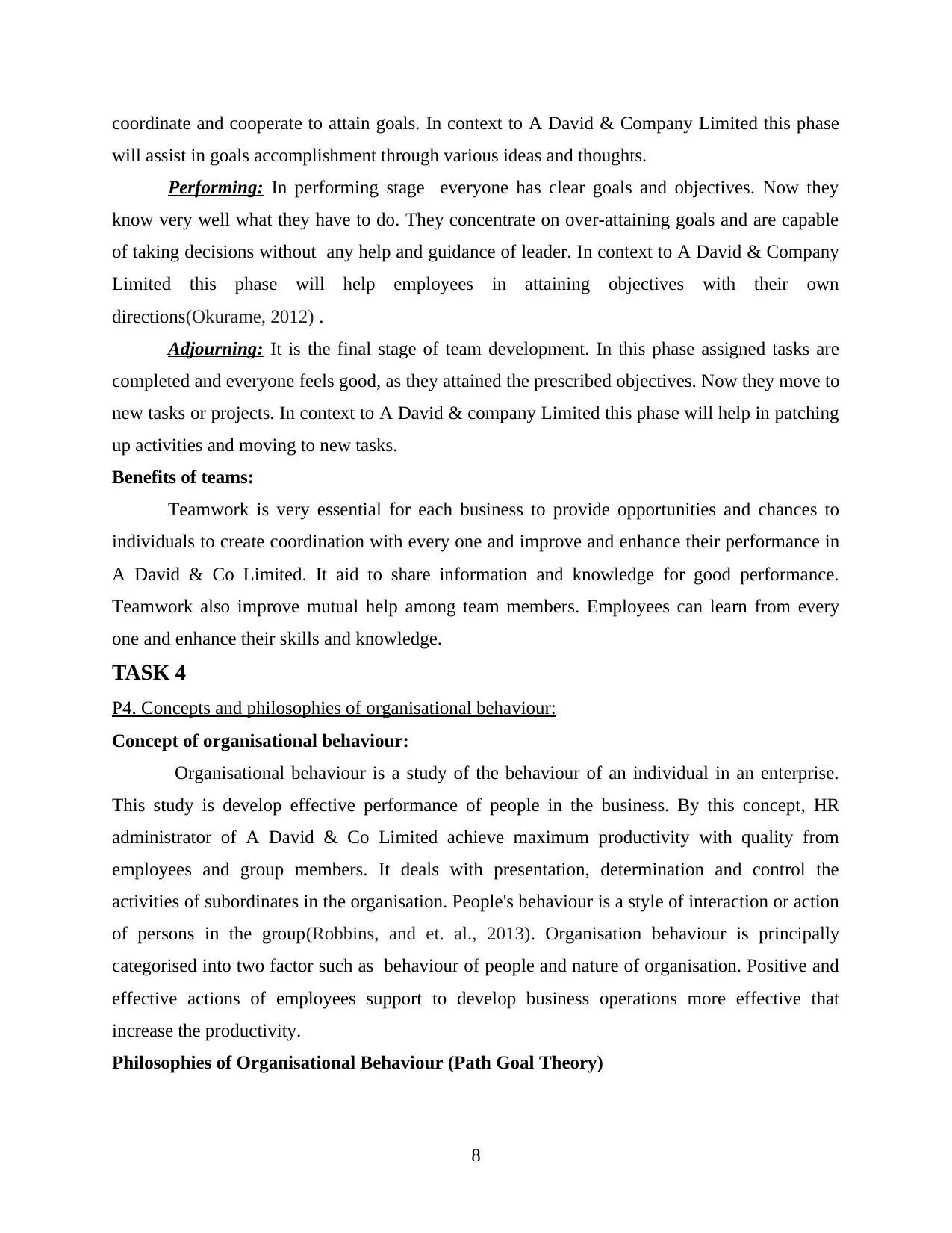
coordinate and cooperate to attain goals. In context to A David & Company Limited this phase
will assist in goals accomplishment through various ideas and thoughts.
Performing: In performing stage everyone has clear goals and objectives. Now they
know very well what they have to do. They concentrate on over-attaining goals and are capable
of taking decisions without any help and guidance of leader. In context to A David & Company
Limited this phase will help employees in attaining objectives with their own
directions(Okurame, 2012) .
Adjourning: It is the final stage of team development. In this phase assigned tasks are
completed and everyone feels good, as they attained the prescribed objectives. Now they move to
new tasks or projects. In context to A David & company Limited this phase will help in patching
up activities and moving to new tasks.
Benefits of teams:
Teamwork is very essential for each business to provide opportunities and chances to
individuals to create coordination with every one and improve and enhance their performance in
A David & Co Limited. It aid to share information and knowledge for good performance.
Teamwork also improve mutual help among team members. Employees can learn from every
one and enhance their skills and knowledge.
TASK 4
P4. Concepts and philosophies of organisational behaviour:
Concept of organisational behaviour:
Organisational behaviour is a study of the behaviour of an individual in an enterprise.
This study is develop effective performance of people in the business. By this concept, HR
administrator of A David & Co Limited achieve maximum productivity with quality from
employees and group members. It deals with presentation, determination and control the
activities of subordinates in the organisation. People's behaviour is a style of interaction or action
of persons in the group(Robbins, and et. al., 2013). Organisation behaviour is principally
categorised into two factor such as behaviour of people and nature of organisation. Positive and
effective actions of employees support to develop business operations more effective that
increase the productivity.
Philosophies of Organisational Behaviour (Path Goal Theory)
8
will assist in goals accomplishment through various ideas and thoughts.
Performing: In performing stage everyone has clear goals and objectives. Now they
know very well what they have to do. They concentrate on over-attaining goals and are capable
of taking decisions without any help and guidance of leader. In context to A David & Company
Limited this phase will help employees in attaining objectives with their own
directions(Okurame, 2012) .
Adjourning: It is the final stage of team development. In this phase assigned tasks are
completed and everyone feels good, as they attained the prescribed objectives. Now they move to
new tasks or projects. In context to A David & company Limited this phase will help in patching
up activities and moving to new tasks.
Benefits of teams:
Teamwork is very essential for each business to provide opportunities and chances to
individuals to create coordination with every one and improve and enhance their performance in
A David & Co Limited. It aid to share information and knowledge for good performance.
Teamwork also improve mutual help among team members. Employees can learn from every
one and enhance their skills and knowledge.
TASK 4
P4. Concepts and philosophies of organisational behaviour:
Concept of organisational behaviour:
Organisational behaviour is a study of the behaviour of an individual in an enterprise.
This study is develop effective performance of people in the business. By this concept, HR
administrator of A David & Co Limited achieve maximum productivity with quality from
employees and group members. It deals with presentation, determination and control the
activities of subordinates in the organisation. People's behaviour is a style of interaction or action
of persons in the group(Robbins, and et. al., 2013). Organisation behaviour is principally
categorised into two factor such as behaviour of people and nature of organisation. Positive and
effective actions of employees support to develop business operations more effective that
increase the productivity.
Philosophies of Organisational Behaviour (Path Goal Theory)
8
Paraphrase This Document
Need a fresh take? Get an instant paraphrase of this document with our AI Paraphraser
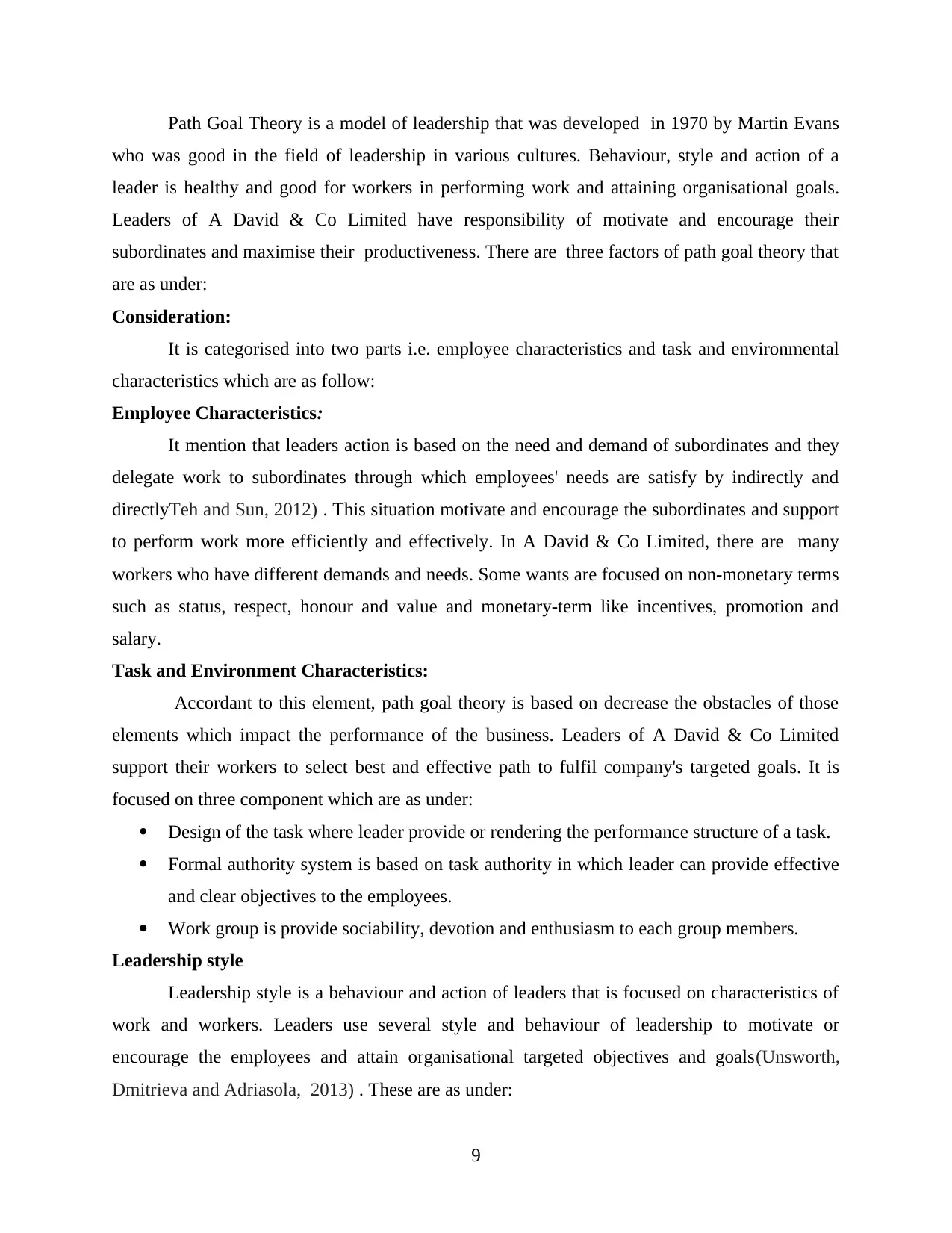
Path Goal Theory is a model of leadership that was developed in 1970 by Martin Evans
who was good in the field of leadership in various cultures. Behaviour, style and action of a
leader is healthy and good for workers in performing work and attaining organisational goals.
Leaders of A David & Co Limited have responsibility of motivate and encourage their
subordinates and maximise their productiveness. There are three factors of path goal theory that
are as under:
Consideration:
It is categorised into two parts i.e. employee characteristics and task and environmental
characteristics which are as follow:
Employee Characteristics:
It mention that leaders action is based on the need and demand of subordinates and they
delegate work to subordinates through which employees' needs are satisfy by indirectly and
directlyTeh and Sun, 2012) . This situation motivate and encourage the subordinates and support
to perform work more efficiently and effectively. In A David & Co Limited, there are many
workers who have different demands and needs. Some wants are focused on non-monetary terms
such as status, respect, honour and value and monetary-term like incentives, promotion and
salary.
Task and Environment Characteristics:
Accordant to this element, path goal theory is based on decrease the obstacles of those
elements which impact the performance of the business. Leaders of A David & Co Limited
support their workers to select best and effective path to fulfil company's targeted goals. It is
focused on three component which are as under:
Design of the task where leader provide or rendering the performance structure of a task.
Formal authority system is based on task authority in which leader can provide effective
and clear objectives to the employees.
Work group is provide sociability, devotion and enthusiasm to each group members.
Leadership style
Leadership style is a behaviour and action of leaders that is focused on characteristics of
work and workers. Leaders use several style and behaviour of leadership to motivate or
encourage the employees and attain organisational targeted objectives and goals(Unsworth,
Dmitrieva and Adriasola, 2013) . These are as under:
9
who was good in the field of leadership in various cultures. Behaviour, style and action of a
leader is healthy and good for workers in performing work and attaining organisational goals.
Leaders of A David & Co Limited have responsibility of motivate and encourage their
subordinates and maximise their productiveness. There are three factors of path goal theory that
are as under:
Consideration:
It is categorised into two parts i.e. employee characteristics and task and environmental
characteristics which are as follow:
Employee Characteristics:
It mention that leaders action is based on the need and demand of subordinates and they
delegate work to subordinates through which employees' needs are satisfy by indirectly and
directlyTeh and Sun, 2012) . This situation motivate and encourage the subordinates and support
to perform work more efficiently and effectively. In A David & Co Limited, there are many
workers who have different demands and needs. Some wants are focused on non-monetary terms
such as status, respect, honour and value and monetary-term like incentives, promotion and
salary.
Task and Environment Characteristics:
Accordant to this element, path goal theory is based on decrease the obstacles of those
elements which impact the performance of the business. Leaders of A David & Co Limited
support their workers to select best and effective path to fulfil company's targeted goals. It is
focused on three component which are as under:
Design of the task where leader provide or rendering the performance structure of a task.
Formal authority system is based on task authority in which leader can provide effective
and clear objectives to the employees.
Work group is provide sociability, devotion and enthusiasm to each group members.
Leadership style
Leadership style is a behaviour and action of leaders that is focused on characteristics of
work and workers. Leaders use several style and behaviour of leadership to motivate or
encourage the employees and attain organisational targeted objectives and goals(Unsworth,
Dmitrieva and Adriasola, 2013) . These are as under:
9
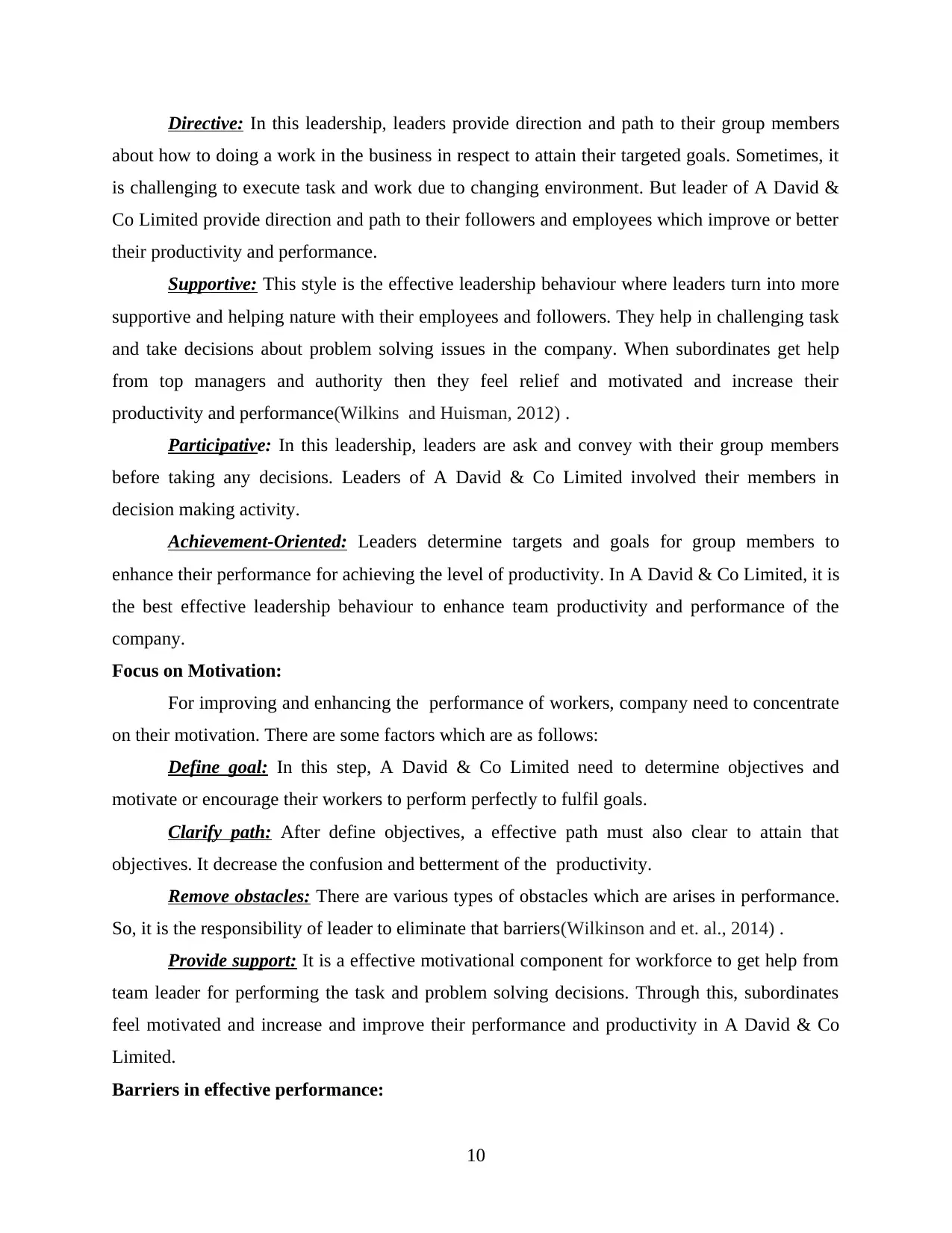
Directive: In this leadership, leaders provide direction and path to their group members
about how to doing a work in the business in respect to attain their targeted goals. Sometimes, it
is challenging to execute task and work due to changing environment. But leader of A David &
Co Limited provide direction and path to their followers and employees which improve or better
their productivity and performance.
Supportive: This style is the effective leadership behaviour where leaders turn into more
supportive and helping nature with their employees and followers. They help in challenging task
and take decisions about problem solving issues in the company. When subordinates get help
from top managers and authority then they feel relief and motivated and increase their
productivity and performance(Wilkins and Huisman, 2012) .
Participative: In this leadership, leaders are ask and convey with their group members
before taking any decisions. Leaders of A David & Co Limited involved their members in
decision making activity.
Achievement-Oriented: Leaders determine targets and goals for group members to
enhance their performance for achieving the level of productivity. In A David & Co Limited, it is
the best effective leadership behaviour to enhance team productivity and performance of the
company.
Focus on Motivation:
For improving and enhancing the performance of workers, company need to concentrate
on their motivation. There are some factors which are as follows:
Define goal: In this step, A David & Co Limited need to determine objectives and
motivate or encourage their workers to perform perfectly to fulfil goals.
Clarify path: After define objectives, a effective path must also clear to attain that
objectives. It decrease the confusion and betterment of the productivity.
Remove obstacles: There are various types of obstacles which are arises in performance.
So, it is the responsibility of leader to eliminate that barriers(Wilkinson and et. al., 2014) .
Provide support: It is a effective motivational component for workforce to get help from
team leader for performing the task and problem solving decisions. Through this, subordinates
feel motivated and increase and improve their performance and productivity in A David & Co
Limited.
Barriers in effective performance:
10
about how to doing a work in the business in respect to attain their targeted goals. Sometimes, it
is challenging to execute task and work due to changing environment. But leader of A David &
Co Limited provide direction and path to their followers and employees which improve or better
their productivity and performance.
Supportive: This style is the effective leadership behaviour where leaders turn into more
supportive and helping nature with their employees and followers. They help in challenging task
and take decisions about problem solving issues in the company. When subordinates get help
from top managers and authority then they feel relief and motivated and increase their
productivity and performance(Wilkins and Huisman, 2012) .
Participative: In this leadership, leaders are ask and convey with their group members
before taking any decisions. Leaders of A David & Co Limited involved their members in
decision making activity.
Achievement-Oriented: Leaders determine targets and goals for group members to
enhance their performance for achieving the level of productivity. In A David & Co Limited, it is
the best effective leadership behaviour to enhance team productivity and performance of the
company.
Focus on Motivation:
For improving and enhancing the performance of workers, company need to concentrate
on their motivation. There are some factors which are as follows:
Define goal: In this step, A David & Co Limited need to determine objectives and
motivate or encourage their workers to perform perfectly to fulfil goals.
Clarify path: After define objectives, a effective path must also clear to attain that
objectives. It decrease the confusion and betterment of the productivity.
Remove obstacles: There are various types of obstacles which are arises in performance.
So, it is the responsibility of leader to eliminate that barriers(Wilkinson and et. al., 2014) .
Provide support: It is a effective motivational component for workforce to get help from
team leader for performing the task and problem solving decisions. Through this, subordinates
feel motivated and increase and improve their performance and productivity in A David & Co
Limited.
Barriers in effective performance:
10
⊘ This is a preview!⊘
Do you want full access?
Subscribe today to unlock all pages.

Trusted by 1+ million students worldwide
1 out of 15
Related Documents
Your All-in-One AI-Powered Toolkit for Academic Success.
+13062052269
info@desklib.com
Available 24*7 on WhatsApp / Email
![[object Object]](/_next/static/media/star-bottom.7253800d.svg)
Unlock your academic potential
Copyright © 2020–2025 A2Z Services. All Rights Reserved. Developed and managed by ZUCOL.





